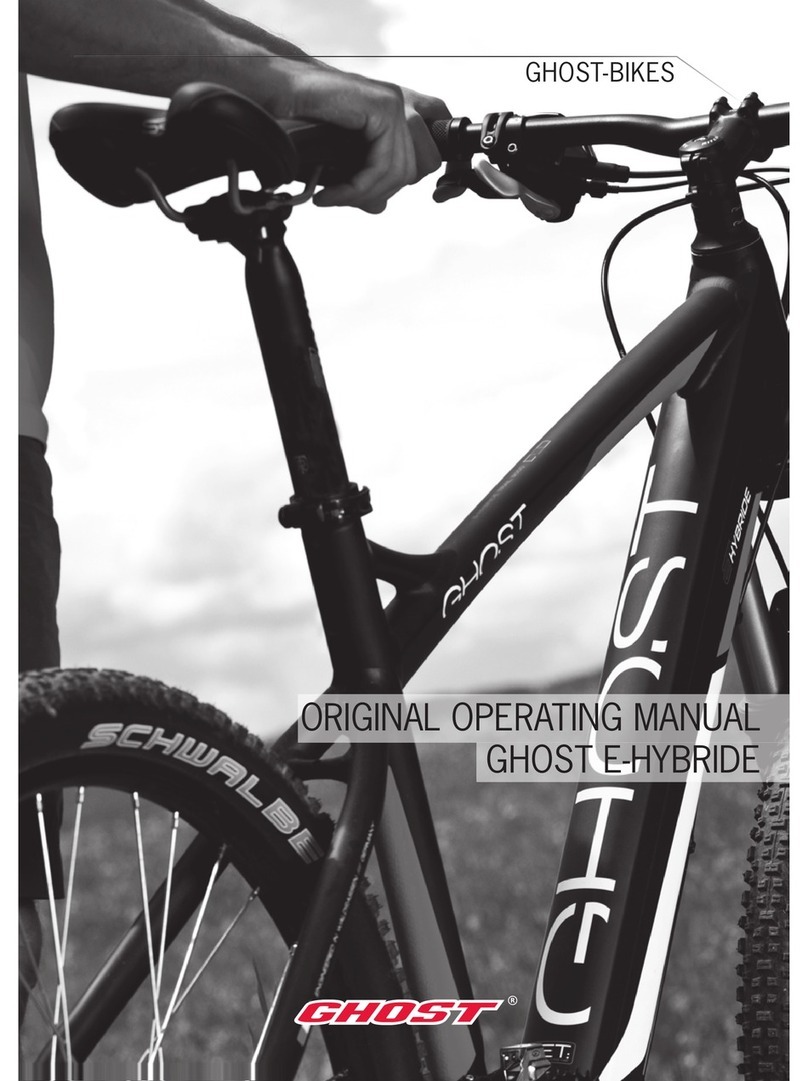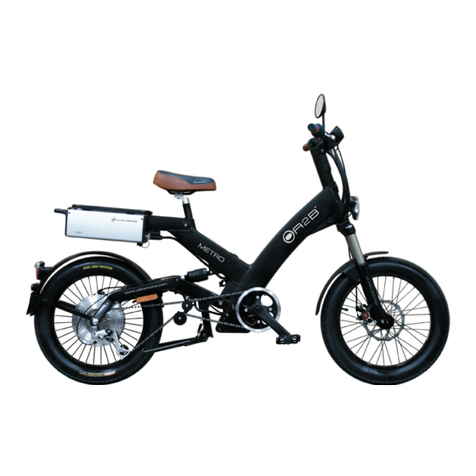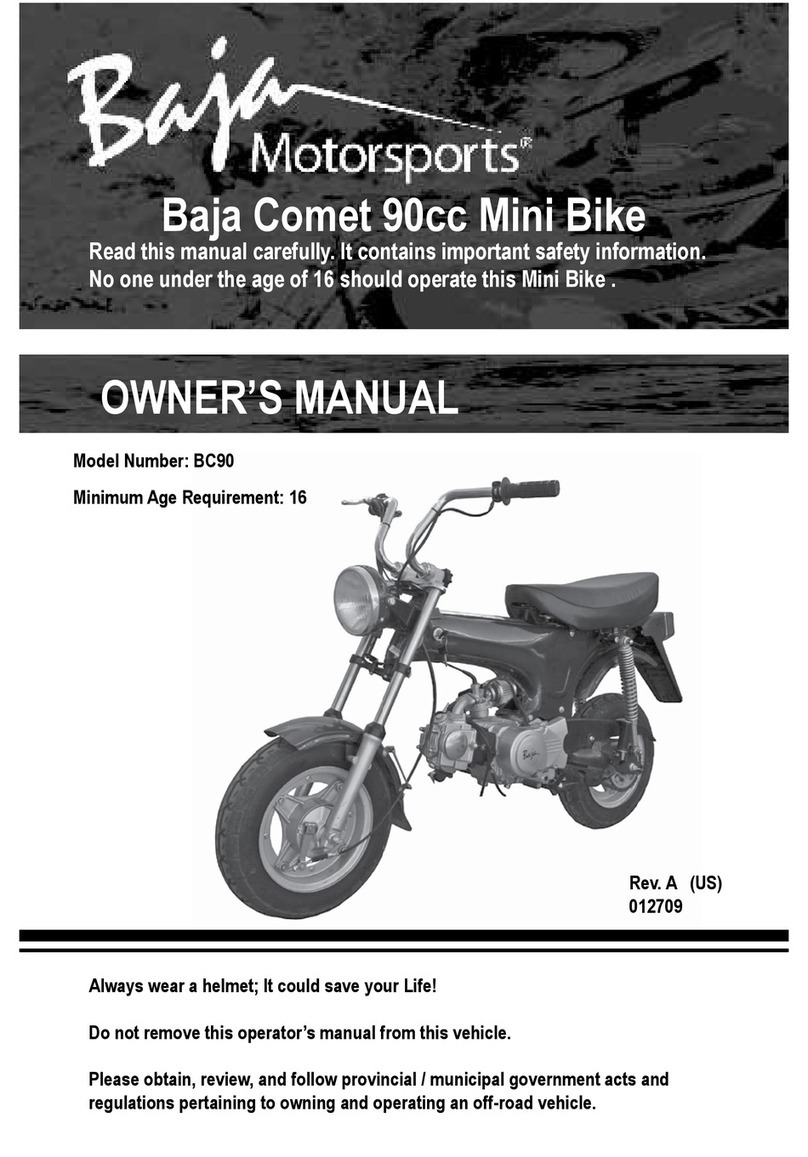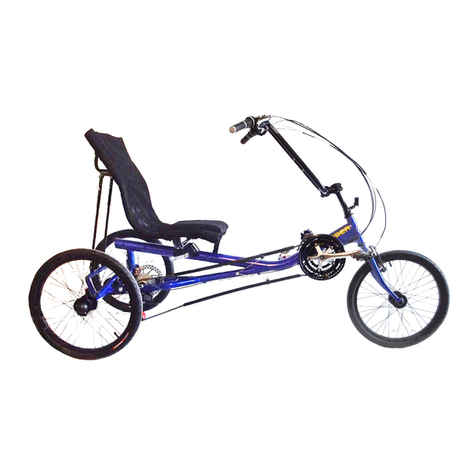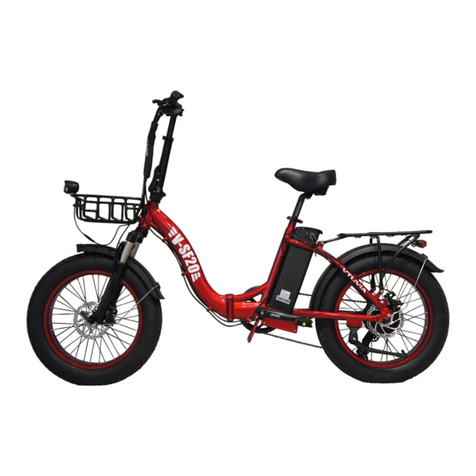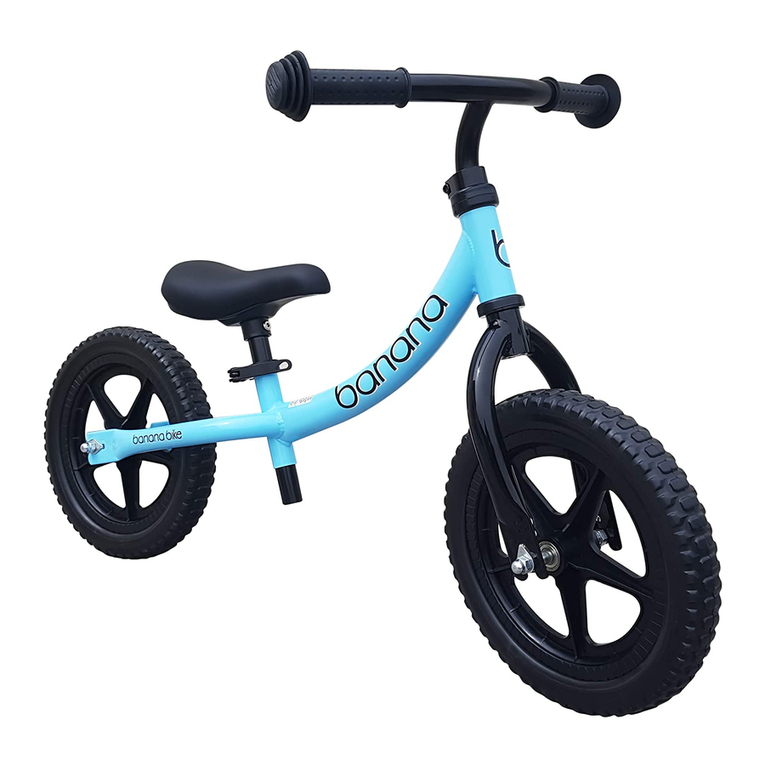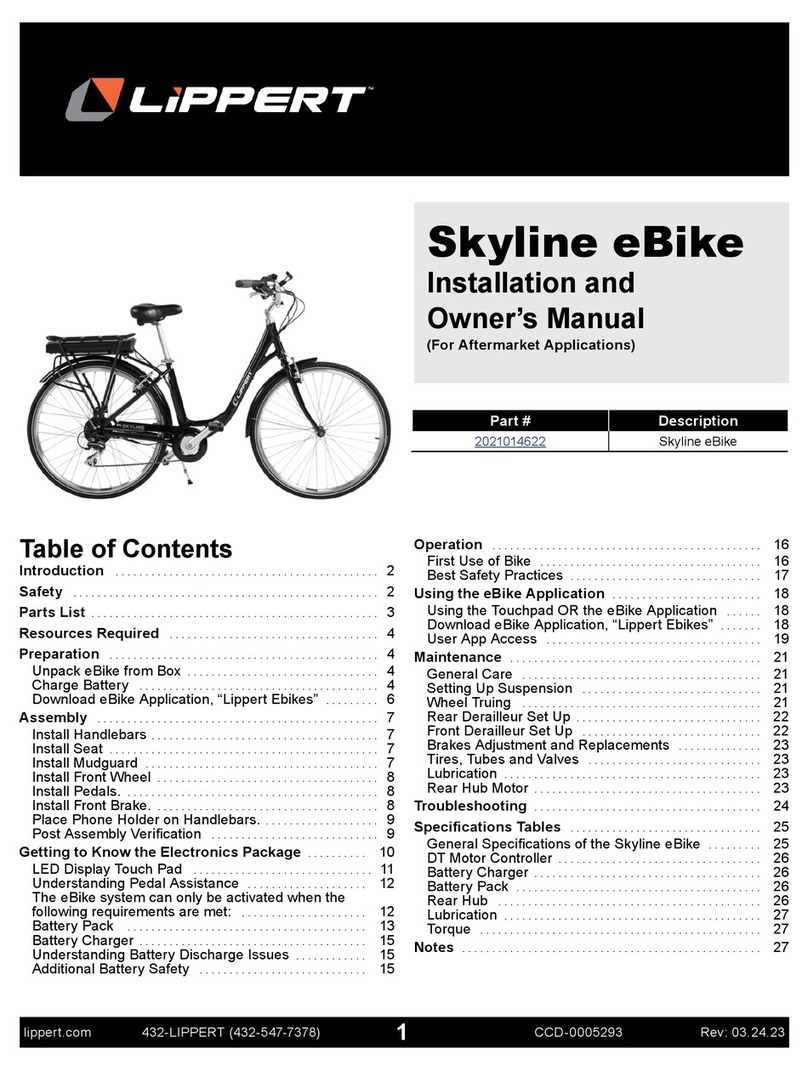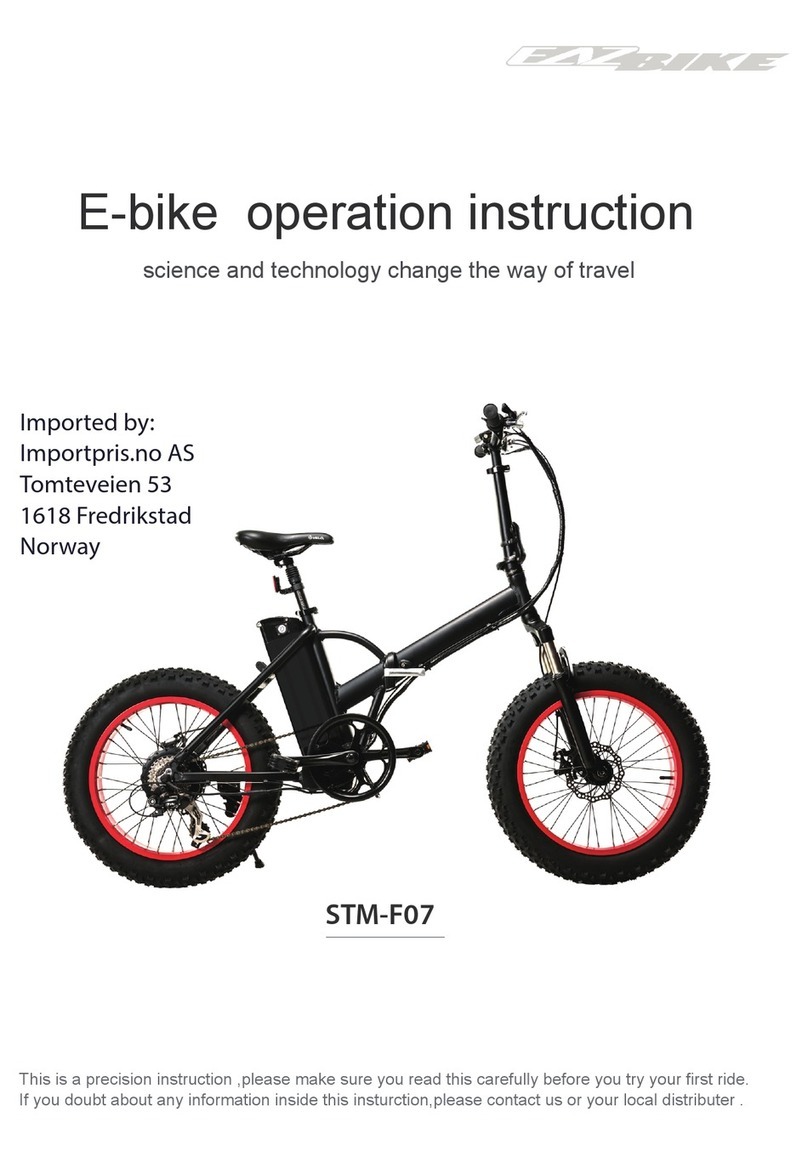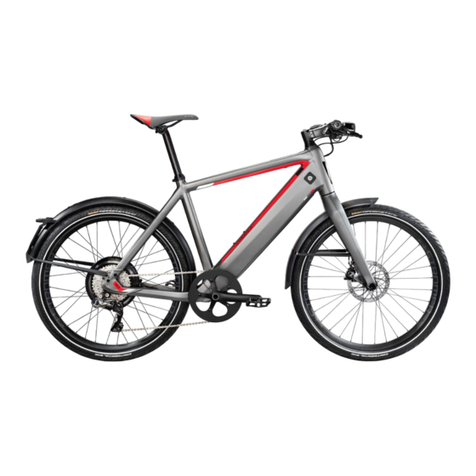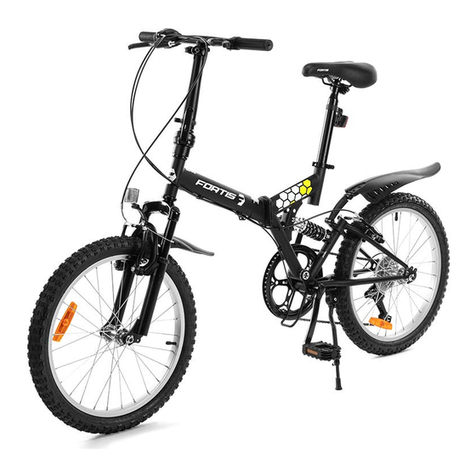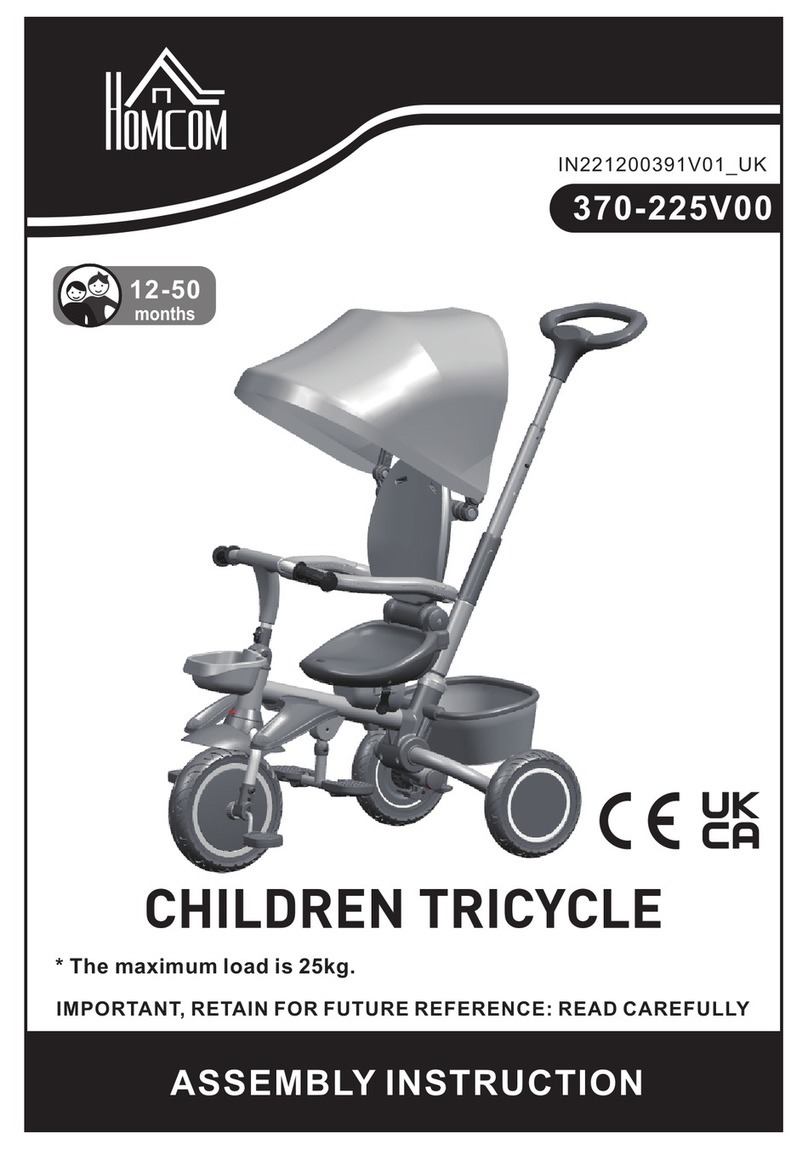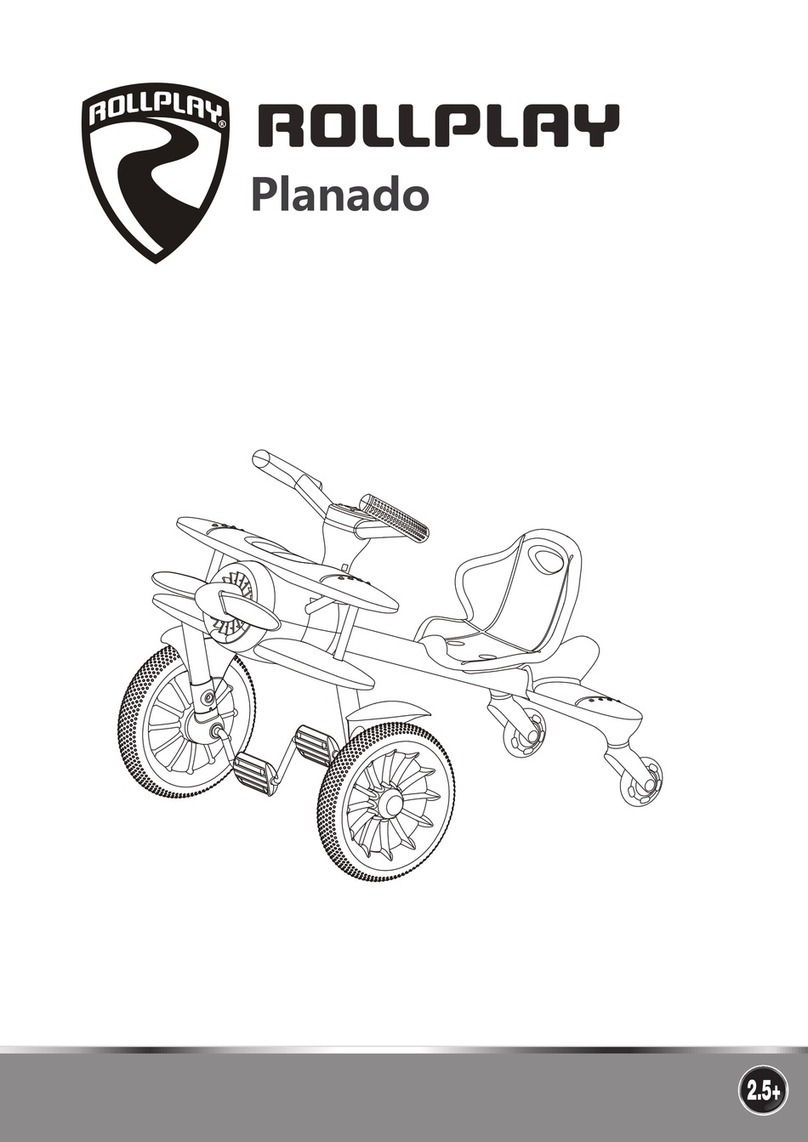Ghost Bike User manual

User manUal

2
User Manual
for GHOST Bikes
Version 12.01

GHOST-bikeS
3
1. Fundamental Information on your new Bike
and this User Manual 7
1.1 Scope 7
1.2 Scope of supply 7
1.2.1 Basic equipment 7
1.2.2 Optional accessories for installation by the specialist bicycle dealer 7
1.3 Other applicable documents 7
1.4 Legal regulations 8
1.5 Conventions 9
1.5.1 Symbols and signal words 9
1.5.2 Abbreviations 9
1.5.3 Technical terms 10
1.5.4 Representation 11
2. For Your Safety 11
2.1 Follow the instructions in this user manual 11
2.2 Please consult your dealer 12
2.3 Use your bike for its intended purpose 12
2.3.1 What work may you carry out yourself on your bike? 12
2.3.2 What must you bear in mind when retrotting accessories and carrying out
conversions? 12
2.3.3 Who is allowed to ride your bike? 13
2.3.4 Where are you allowed to ride your bike? 14
3. Technical Data 17
3.1 Permitted temperatures and permitted total weight 17
3.2 Tightening torques for screw connections 17
4. Design and Function 18
4.1 Types, categories, ranges 18
4.1.1 Mountain bike (Fully + Hardtail) 19
4.1.1.1 Fully 19
4.1.1.2 Hardtail 21
4.1.2 Cross bike (CROSS range) 22
4.1.3 Racing bike/tness bike (RACE, SPEEDLINE ranges) 23
4.1.4 Trekking and city bike (TREKKING, CITYLINE range) 24
4.1.5 Children's and teenagers' bike (POWERKID range) 25
4.2 Frame and fork 26
4.3 Brakes 28
4.3.1 Brake assignment 28
4.3.2 Brake type 28
4.4 Gears 31
4.4.1 Derailleur 32
4.4.2 Hub gear 32
4.4.3 Gear change 32
4.5 Clamping systems for wheels and saddle post 34

4
4.6 Materials 35
4.6.1 Breakdown 35
4.6.2 Information and instructions on the carbon material 35
4.6.2.1 Information on the frame construction 36
4.6.2.2 Proper handling of carbon parts 36
4.7 Tyres 37
5. Frame Sets 38
6. Before Using for the First Time 38
7. Before Every Use 38
7.1 Inspecting the wheels 39
7.1.1 Checking the position and tight t 40
7.1.2 Checking the wheel rims 40
7.1.2.1 Checking the rims for wear (only applies to bikes with rim brakes) 40
7.1.2.2 Checking the rims for wobble 41
7.1.2.3 Checking the rims for soiling (only applies to bikes with rim brakes) 41
7.1.2.4 Checking the tyre 41
7.1.2.5 Checking that the tyre is correctly tted 42
7.1.2.6 Checking valve position (not on tubeless tyres) 42
7.1.2.7 Checking the air pressure 42
7.1.3 Checking other points 43
7.2 Inspecting the saddle and saddle post 43
7.3 Inspecting the handlebars and handlebar stem 45
7.4 Inspecting the handlebar attachments 46
7.5 Inspecting the headset 47
7.6 Inspecting the spring fork 48
7.7 Inspecting the rear wheel suspension 48
7.8 Inspecting the brakes 48
7.8.1 Checking general functions 49
7.8.2 Checking the hydraulic disc brake 49
7.8.3 Checking the hydraulic rim brakes 50
7.8.4 Checking the rim brake with cable (MTB version) 51
7.8.5 Checking the rim brake with cable (racing bike version) 53
7.8.6 Checking the back-pedal brake 55
7.9 Inspecting the drive and chain 55
7.10 Inspecting the lighting system 55
7.11 Inspecting the luggage rack 56
7.12 Inspecting the mudguards 56
7.13 Checking the side stands 57
7.14 Checking parts specic to children's bikes 58
7.15 Checking other points 58

GHOST-bikeS
5
8. Adjusting and Operating the Bike 59
8.1 Adjusting the saddle height 59
8.2 Adjusting the spring fork 59
8.2.1 Forks with air suspension 59
8.2.1.1 Adjusting the air pressure 59
8.2.1.2 Switching the suspension on and off 60
8.2.2 Forks without air suspension 61
8.3 Adjusting the rear wheel suspension 61
8.4 Operating the gear shift 61
8.4.1 Derailleur 61
8.4.1.1 Switching to a larger chainring/sprocket 62
8.4.1.2 Switching to a smaller chainring/sprocket 64
8.4.2 Hub gear 67
8.4.2.1 Switching to a lower gear 67
8.4.2.2 Switching to a higher gear 68
8.5 Using the brakes 68
8.6 Operating the clamping systems for wheels and the saddle post 69
8.6.1 Opening and closing the quick-release axle on the wheel 69
8.6.1.1 Opening the quick-release axle 69
8.6.1.2 Closing the quick-release axle 70
8.6.2 Opening and closing the thru axle on the wheel 72
8.6.2.1 Opening the thru axle 72
8.6.2.2 Closing the thru axle 73
8.6.3 Opening and closing the quick-release axle on the saddle post clamping 74
8.6.3.1 Opening the quick-release axle on the saddle post clamping 74
8.6.3.2 Closing the quick-release axle on the saddle post clamping 75
8.6.4 Screw-nut clamping on wheels 76
8.6.5 Opening and closing the screw-nut clamping on saddle posts 76
8.6.5.1 Opening the screw-nut clamping on the saddle post 76
8.6.5.2 Closing the screw-nut clamping on the saddle post 77
9. Loading the Bike 77
10. Riding the Bike 80
11. What to do in the Case of a Fall or Accident 81
11.1 Basics 81
11.2 Carbon frame 82
12. Parking the Bike safely 82
12.1 Bikes with side stands 82
12.2 Bikes without side stands 83

6
13. Transporting the Bike 83
13.1 Dismantling and installing wheels 84
13.1.1 Dismantling the front wheel 85
13.1.2 Installing the front wheel 86
13.1.3 Dismantling the rear wheel 87
13.1.4 Installing the rear wheel 88
13.1.5 Opening and closing the brakes 89
13.1.5.1 Opening the Magura HS 33 hydraulic rim brake 89
13.1.5.2 Closing the Magura HS 33 hydraulic rim brake 90
13.1.5.3 Opening the MTB and Trekking (V-Brake) rim brake 90
13.1.5.4 Closing the MTB and Trekking (V-Brake) rim brake 91
13.1.5.5 Opening the rim brake of the racing bike 92
13.1.5.6 Closing the rim brake of the racing bike 92
13.2 Dismantling and installing saddle post with saddle 92
13.2.1 Dismantling the saddle post 92
13.2.2 Installing the saddle post 93
14. Maintaining the Bike 94
14.1 Your servicing and maintenance plan 95
14.2 How to clean and care for your bike 95
14.3 Workshop service 97
15. Faults When Riding 98
15.1 Gear shift, drive 98
15.2 Brakes 99
15.3 Frame, saddle post and suspension 100
15.4 Mudguards, luggage rack, lights 102
15.5 Wheels and tyres 102
15.5.1 Changing the inner tube and tyre 103
16. Storing the Bike for Prolonged Periods 105
17. Disposing of the Bike 105
18. Warranty, Guarantee 105
18.1 General 105
18.2 Stability guarantee on frames from model year 2011 105
19. Overviews showing all of the Bicycle Components 107
20. Imprint 112

GHOST-bikeS
7
Dear Customer,
We wish to congratulate you on your choice of a bike from our company, and to thank you for the faith placed
in us.
With your bike you have acquired a high-quality, environmentally-friendly sports model with which you will
have a great deal of pleasure while at the same time doing something to improve your health.
1. Fundamental Information on your new Bike and this User Manual
This user manual is a very important document.
Please read this manual carefully before using your bike for the rst time and keep it in a safe place.
1.1 Scope
This user manual applies exclusively to bikes made by GHOST from the 2012 model year on, as referred to
in sections 4.1 to 4.1.5.
This manual does not apply to GHOST epacs or pedelecs.
1.2 Scope of supply
1.2.1 Basic equipment
• Complete bike (various models without pedals) or frame set
• In the case of carbon frames: assembly paste
• In the case of disc brakes: transport securing device
• User manual in your national language
1.2.2 Optional accessories for installation by the specialist bicycle dealer
Please refer to section 2.3.2, What must you bear in mind when retrotting accessories and carrying out con-
versions? to nd out the optional accessories you can use to retrot your bike.
1.3 Other applicable documents
• Delivery certicate
The delivery certicate is an important accompanying document which your specialist bicycle dealer has
completed and handed over to you. This contains key data and other data about your bike.
• The delivery certicate provides information on which Component user manuals are enclosed.
These contain product-specic information.
Due to the wide variety of components available, not all of the components mounted on your bike can be
described in this manual. User information which is important for you is enclosed as a separate document
and is referred to in the delivery certicate.
The instructions and information contained therein must be given priority and are to be followed!

8
• New technical developments may result in changes to the models, their technical data and documentation
at short notice. If these changes are relevant to handling the bike and your safety, the associated user infor-
mation is enclosed as a separate document and is referred to in the delivery certicate.
• Please consult your specialist retailer concerning the up-to-dateness of the technical data.
1.4 Legal regulations
As a road user you have to abide by the trafc regulations in your country.
In Germany you do not need any ofcial authorisation for your bike.
On public roads and paths you are only allowed to ride your bike if you retrot it with the equipment which is
stipulated by law in your country. In Germany these requirements are laid down in the German highway code
(StVZO).
This requires the following equipment:
• Two independently functioning brakes
• A bell
• Dynamo-powered lights for front (white light) and rear (red light)
• Racing bikes under 11 kg are exempted from the dynamo obligation. On racing bikes which are exempted
from the dynamo obligation you must have approved battery lighting during the day. For the duration of the
participation in races, racing bikes are exempted from this obligation.
• White reector at the front (often integrated into the front headlight) and two red reectors at the back (one
of which is often integrated into the back light)
• Two yellow reectors each for front and rear wheel; alternatively: tyres with reective stripes attached on
both sides
• Two yellow reectors each for right and left pedal
• All lighting components and reector parts must be explicitly approved for bikes. Please consult your spe-
cialist retailer on this.
• For the full wording of the regulations in Germany, please refer to the StVZO or consult your dealer.
• The exact legal text with details can be found on the Internet at the following address:
http://www.gesetze-im-internet.de/stvzo/ (correct as of: January 2012)
• For use outside Germany, please observe the trafc regulations applicable in your country. Consult your
dealer or the responsible authorities.
NOTE:
All of the equipment required by law in Germany is contained in the scope of delivery of your bike for the fol-
lowing ranges/models: TREKKING
Please consult your specialist bicycle dealer exclusively for all other bicycle models. He or she will be pleased
to advise you.

GHOST-bikeS
9
1.5.2 Abbreviations
Abbreviation Meaning
°Degree, measure of angle size
bar Common unit of measure for air pressure
°C Degrees Celsius, unit of temperature
DIN German Institute for Standardisation
EN European norm
EPAC
Electric Power Assisted Cycles, also pedelec (pedal electric)
Bike with an additional electric drive which only operates when the driver
also pedals at the same time.
hHour(s)
HWK Chamber of Crafts (in Germany)
IHK Chamber of Commerce and Industry (in Germany)
km/h Kilometres per hour, unit of speed
kg Kilogram, unit of mass
MTB Mountain bike
Nm Newton-metre, unit of torque
Pedelec see EPAC
psi pound per square inch, American unit of pressure (1 psi = 0.06897 bar)
RH Frame height
StVO Highway Code (in Germany)
SW Wrench size, measure of tool sizes
1.5 Conventions
1.5.1 Symbols and signal words
Symbol and signal word Meaning
This draws your attention to how to deal with and the
effects of safety information.
WARNING
This draws your attention to a dangerous situation
which might result in death or injury if it is not avoid-
ed.
CAUTION
This draws your attention to a dangerous situation
which might result in slight to moderate injury if it is
not avoided.
NOTE This draws your attention to possible damage to property and
other important information.

10
1.5.3 Technical terms
Technical
Term Meaning
Wobble Colloquial term for radial eccentricity of the rim
Torque Also tightening torque. This states how much a screw should be tightened.
Dealer/approved
workshop
A business which is authorised by the authorities and the manufacturer to
call itself a specialist business for the sale and repair of conventional bikes.
Hand force The force that an average adult can apply with moderate to average effort
using one hand.
Manometer Air pressure measuring device
Correctly tight-
ened
Permanent screw connection in which the screw heads are positioned tightly
against the component over their entire area.
Incorrect screw
connection
A screw connection which is too loose and where the screw heads are not
positioned tightly against the component over their entire area. This can gen-
erally be recognised by a gap between the screw head and component.

GHOST-bikeS
11
1.5.4 Representation
In this user manual we use the following representation rules:
• Safety instructions are represented with a symbol, a signal word and in bold, see section 1.5.1, Symbols
and signal words.
• Instruction texts are numbered.
• Cross-references are in italics.
• Representations in illustrations are not specic to any particular model. They apply to all bicycle models in
this user manual.
• Here you will nd an illustration with all of the bicycle components and parts referred to in the text:
Section 19, Overviews showing all of the Bicycle Components.
• Position designations: in this manual we use the following names for the position of objects in space (posi-
tion information): The words left, right, front and rear always refer to the position in the direction of travel.
2. For Your Safety
2.1 Follow the instructions in this user manual
• Readthisusermanualcarefullybeforeusingyourbikeforthersttime.
• Pleaseensurethatyourspecialistbicycledealerhascompletedthedeliverycerticateforyour
bikeandthatyouhavereceivedallofthedocumentsreferredtointhedeliverycerticate.
• You should contact your specialist bicycle dealer if any items are missing.
• Please ride your bike only after you have received all of the documentation and read it carefully.
• If you sell or give your bike to somebody as a present, you should also pass on this user manual to
the new owner.
• User manual for children's and teenagers' bikes.
• In this case this user manual is directed at the guardians of the children and youths who use this
bike.
• Where in this user manual sentences such as “You can get ...”, “Have your bike...” etc. occur, these
are directed in each case at the child or youth and his/her bike.
• Go through this user manual together and explain all the points to your child, in particular the
safety precautions.
• As guardian you are responsible for ensuring the safety of this bike and its proper use.

12
2.2 Please consult your dealer
NOTE:
Even after providing advice and carrying out the nal assembly, your bike dealer is still very important to you.
He or she is your contact person for all types of servicing and maintenance, conversions and repairs. Please
contact your specialist bicycle dealer if you have any questions concerning your bike.
2.3 Use your bike for its intended purpose
If you do not use your bike in accordance with the designated purpose this may result in dangerous
riding situations, falls and accidents.
You should always use your bike as described in this user manual and any additional documentation
that you may have.
2.3.1 What work may you carry out yourself on your bike?
Faults caused by incorrectly performed work to your bike may damage the bike and impair its opera-
tional safety. This can lead to dangerous riding situations, falls and accidents.
• You may only carry out work to your bike which is described as such in this user manual and for
which you have the appropriate tools.
• Do not change the properties of individual components of your bike.
• Allotherworkmayonlybeperformedbyaqualiedspecialistbicycledealer.
2.3.2 What must you bear in mind when retrotting accessories and carrying out conversions?
Theretrottingofaccessoriesandperformanceofconversionswhicharenotpermittedforyourbike
may damage your bike and impair its operational safety. This can lead to dangerous riding situations,
falls and accidents.
• Youshouldneverretrotyourbikeorcarryoutanyconversionsyourself.
• Alwaysselecttheaccessoriesandmodicationpartstogetherwithaspecialistbicycledealer.The
followingaccessoriescanberetrotted:
– Click pedals
– Bicycle computer
– Bottle holder (only if mounting possibility is available)
– Equipment for riding the bike on public roads and paths in accordance with the regulations in force in your
country (only if mounting possibilities are available)
– Luggage rack (only if mounting possibility is available)
– Child seat if you are using a luggage rack which is authorised for a child seat. Please ask your specialist
bicycle dealer. He or she will be pleased to advise you.
– Saddlebags if you are using a luggage rack which is authorised for saddlebags. Please ask your special-
ist bicycle dealer. He or she will be pleased to advise you.

GHOST-bikeS
13
• ThermGHOSTprohibitstheuseofreplacementpartswhichdifferinsizecomparedtotheorigi-
nal parts (such as forks or spring elements with a greater or lower installation height/length/travel,
braking systems with larger brake discs, wider tyres, etc.).
• Forreplacementorretrottingpurposestheonlypartswhichmaybeusedarethosethathave
been approved by GHOST for your bicycle model. Please consult your authorised GHOST special-
ist retailer on this.
• TheretrottingofelectricdrivestobikesmadebyGHOSTisnotpermitted.
• Under no circumstances should you change the properties of the existing bicycle parts.
• Pleaseensurethatyoureceivethedocumentationforyouraccessoriesandmodicationparts
from your specialist bicycle dealer.
• Pleaseensurethatyourspecialistbicycledealernotesdowninthedeliverycerticatewhichdocu-
mentation you have received from him.
• Alwaystakeyourdeliverycerticatewithyouifyoupurchaseaccessoriesandmodicationparts
from your specialist bicycle dealer at a later time.
• Followallofthesafetyinstructionsandspecicationsinthedocumentationforyouraccessories
andmodicationparts.
2.3.3 Who is allowed to ride your bike?
• The rider must be able to ride a bike, i.e. he/she must have the necessary basic knowledge about
the use of a bike and the necessary feeling of balance to be able to steer and control a bike.
• The rider must be able to safely get on and off the bike.
This applies in particular in the case of ergonomically adjusted saddles if the rider's feet cannot
reach the ground when he or she is sitting down.
• The rider must be of the correct height for the bike and the maximum permitted total weight
(see section 3.1, Permitted temperatures and permitted total weight) mustnotbeexceeded:
Correct Frame Height MTB
except NORTHSHORE, DOWNHILL, 4CROSS, DIRT
Height in cm 135-145 145-155 155-165 165-180 180-190 190-195
Frame height in cm 34 40 44 48 52 56
RACE all
Height in cm 160-165 165-175 175-180 180-185 185-190 190-195
Frame height in cm 50 53 56 58 60 62
CROSS, TREKKING, SPEEDLINE
Height in cm 145-155 155-165 165-180 180-190 190-195
Frame height in cm 45 49 53 57 61
CROSS LADY, TREKKING LADY
Height in cm 135-145 145-155 155-165 165-180
Frame height in cm 40 45 48 52

14
NOTE:
The values given here are for guidance only. A smaller or larger frame height may be better, depend-
ing on various factors. Please consult your dealer if you have any questions.
He or she will be pleased to advise you.
• Childrenandyouthsmustbeabletooperatethebikesafely.Thetypeofbike,sizeandoperating
elements (e.g. brake levers) must be suitable for children’s hands. Please contact your specialist
dealer on this. He or she will be pleased to advise you.
• Physicalandmentaltness:iftheriderwouldliketorideonpublicroadsandpaths:theridermust
be physically and mentally able to ride the bike on public roads.
NOTE:
Information on the technical conditions of approval for use on public roads can be found in
section 1.4, Legal regulations.
2.3.4 Where are you allowed to ride your bike?
If you overload your bike by riding on roads, paths and slopes for which your bike is not suited, it is
possible that parts of your bike will break or fail. This can lead to dangerous riding situations, falls
and accidents.
You should only ride your bike on roads, paths and slopes which are authorised for your model ac-
cordingtothefollowingclassication.
NOTE:
All bikes are divided up into categories
(see the following classication and section 4.1, Types, categories, ranges).
Explanations of the following categorisation
Symbol Meaning
X permitted
- not permitted
X* On public roads and paths only permitted with additional equipment re-
quired by law, see section 1.4, Legal regulations.

GHOST-bikeS
15
Designation Denition
Road Asphalt-covered routes
Paved paths Paths with a solid surface such as sand, gravel or similar items (e.g., for-
est path, dirt road)
Cross-country
Terrain includes roads, wood,
eld, gravel, crushed rock, for-
est paths, multiple ascents and
descents
Routes with loose surface, roots, rises,
stones, ledges, etc.
With increasing suspension travel dis-
tance, the terrain on which the wheels
move also becomes increasingly
coarser. The downhill ride on rough
terrain becomes more and more im-
portant. The quality of the uphill ride is
maintained with sophisticated suspen-
sions, but becomes less important in
the freeride category at the latest. The
construction of the wheels is adapted to
the more extreme riding conditions.
All mountain tour
All mountain trail
Enduro
Freeride
Downhill
High downhill speed on rough
terrain, loose rocks, large roots,
long jumps and strong impacts
dene these riding conditions
Dirt Trails specially created for this type of bike (BMX trails)
Sports park Terrain specically designated for freeride / downhill / dirt
Jumps
NOTE:
The execution of jumps with these bikes is generally permitted, although
they are performed at your own risk. You should attend appropriate riding
technique seminars to develop a feeling for which jumps are possible
with which bikes. Corresponding skill and experience are the precondi-
tions for the use of these sports bikes!

16
Model Riding Conditions / Category
Road
Paved paths
Cross-country
All mountain tour
All mountain trail
Enduro
Freeride
Downhill
Dirt
Sports park
Jumps
SE, EBS COMP, EBS PRO, MISS,
POWERKID X*XX--------
RT, MISS RT, HTX, EBS HTX X*XX--------
AMR, MISS AMR, EBS AMR, ASX X* X X X - - - - - - -
AMR PLUS X* X X X X - - - - - -
CAGUA X* X X X X X - - - - -
NORTHSHORE X*XXXXXX- - XX
DOWNHILL X*XXXXXXX- XX
4CROSS, DIRT X* X - - - - - - X X X
RACE, EBS RACE, SPEEDLINE X*----------
TREKKING XX---------
CROSS X* X - - - - - - - - -
NOTE:
Bikes of other categories can also be tted with racing bike or racing bike-type tyres. Such tyres can be
recognised from the maximum width of 28 mm indicated e.g. by two numbers on the side of the tyre such as
28-622 or 28-559. The instructions for ROAD RACE apply to these bikes. The tyre size is marked on the tyre
wall.
Your safety on roads paths and cross-country terrain depends on your speed.
The higher your speed, the greater your risk!
• Note that all streets and paths may be damaged or have obstacles that can threaten your safety and
damage your bike.
• In such areas ride particularly slowly and carefully. If necessary push or carry your bike over such
obstacles. Use the bike exclusively as a pure means of travel.
• There is a danger of falling if you ride the bike in a sporty manner, perform jumps or ride at high
speed. Adapt the use of your bike to your riding skills.

GHOST-bikeS
17
3. Technical Data
3.1 Permitted temperatures and permitted total weight
Admissible ambient tem-
peratures -10 to +50°C
Maximum permitted overall
weight
MTB incl. DOWNHILL, NORTHSHORE, 4X, DIRT: 120 kg
CROSS, SPEEDLINE, RACE: 120 kg
TREKKING: 140 kg
POWERKID 24": 100 kg
POWERKID 20": 80 kg
POWERKID 16"/12": 50 kg
3.2 Tightening torques for screw connections
Component Manufac-
turer
Model/
Type Connection Type of
Connection
Tightening
torque (Nm)
Saddle support
clamping to
frame
All Aluminium
frame
Saddle sup-
port clamping One screw 5 - 8
Saddle support
clamping to
frame
All Carbon
frame
Saddle sup-
port clamping One screw 5 - 6

18
4. Design and Function
4.1 Types, categories, ranges
We produce various types of bikes. We have divided up these types into different categories and product
ranges.
NOTE:
The categorisation can be found in section 2.3.4, Where are you allowed to ride your bike?
Type Product range
Equipment stand-
ard according to
German Highway
Code
Hub Dynamo
Front Wheel
Mountainbike
(MTB)
Fully
• RT
• MISS RT
• AMR
• MISS AMR
• EBS AMR
• ASX
• AMR PLUS
• CAGUA
• NORTHSHORE
• DOWNHILL
- -
Hardtail
• SE
• EBS COMP/PRO
• MISS
• HTX
• EBS HTX
• 4CROSS
• DIRT
- -
Crossbike CROSS - -
Racing bike, tness bike
RACE
EBS RACE
SPEEDLINE
- -
Trekking and city bike TREKKING X X
Children's and
teenagers' bike
Hardtail
• POWERKID 20"
• POWERKID 24"
- -
Hardtail with
rigid front wheel
fork
• POWERKID 12"
• POWERKID 16"
- -

GHOST-bikeS
19
4.1.1 Mountain bike (Fully + Hardtail)
No equipment according to German Highway Code, dérailleur, rim or disc brakes, wheels with rim diameters
of 559 mm, 584 mm or 622 mm and a minimum tyre width of 52 mm.
4.1.1.1 Fully
• RT, MISS RT ranges:
– Fullies with 100mm suspension travel distance front and rear. Bikes with weight-oriented conguration
for the sporting rider.
• AMR, MISS AMR, EBS AMR, ASX ranges:
– Fullies with 120 mm suspension travel distance front and rear. Equally easy to ride up and down hill.
• AMR Plus range:
– Fullies with 150/120 mm suspension travel distance front and 150 mm rear. Easy to ride up and down
hill. However, more value is placed on the downhill properties.

20
• CAGUA range:
– Fullies: with 150/120 mm suspension travel distance front and 150 mm rear. Easy to ride up and down
hill. However, more value is placed on the downhill properties.
• DOWNHILL, NORTHSHORE ranges:
– Fullies with 200 or 180 mm suspension travel distance front and rear. The main focus here is on the suit-
ability for downhill and bike park.
Other manuals for Bike
1
This manual suits for next models
28
Table of contents
Other Ghost Bicycle manuals
